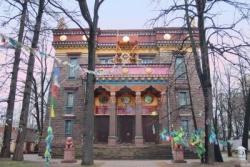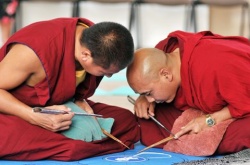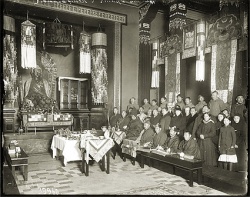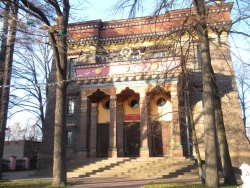Buddhology and Buddhologists in St.-Petersburg (Past and Recent) by Elena Soboleva
Saint-Petersburg is one of the first European capitals where the foundations of scientific research of Buddhism were laid. Sergey Fedorovich Oldenburg, Feodor Ippolitovich Shcherbatskoy, etc. won the international recognition in the XXth century for their contribution to the European Buddology.
But the first name to be written in this list must be Ivan Pavlovich Minaev (1840-1890), the founder of the Russian School of Indology. Senior lecturer (since 1869), than Professor (1873) at the Imperial Saint-Petersburg University, member of the Imperial Russian Geographical Society (1871), he studied ancient, medieval and modern history of the Southern Asia.
He was specially interested in Oriental literatures, philosophy, linguistics, general culture, historical geography, ethnography, folklore. The complex study of The History of Buddhism, its cultural and historic influence on the peoples of the Orient became one of the main topics of Minaev’s research.
Since students’ years Ivan P. Minaev became interested in the Buddhism as the fundamental phenomenon of the spiritual culture in many Oriental countries.
He started with the comprehensive studies of the basic, ancient forms and monuments of this great Doctrine. That is why he concentrated on Southern Buddhism – Hinayana, or Theravada.
Minaev had learned the Pali Language to read the canonical Buddhist texts. Minaev’s master’s thesis was based on the publication of the most ancient Buddhist text “Pratimokshasutra”, actually the collection of ritual instructions (1869, translation into Russian and comments).
His doctoral thesis resulted in the monograph “Essay on Phonetics and Morphology of the Pali Language” (1872). It has been used to teach the Pali Language not only in Europe, but in India, Ceylon and Burma as well. The book has not lost its scientific significance up to our time.
The foreign colleagues acknowledged Minaev’s efforts in the field of Buddhology. His major contribution to science is capital work “Buddhism: Studies and Materials” (1887). Minaev’s speculations on the problems of chronology and interrelation of canonical Mahayana and Hinayana Buddhist compositions significally influenced the development of international Buddhological research.
During his rather short Life Minaev had travelled a lot. He made long-termed voyages to Germany, Great Britain, France to search the libraries and to meet the prominent European specialists in Indology. Three times he went right to Southern Asia (India, Nepal and Ceylon, now – Sri Lanka). We must note that travelling there had been rather complicated: on board of a ship through the seas, in the bull carriage, on a horse, sometimes in quite uncomfortable palanquins. Without air-conditioning in hotels, that could have given some rest from the exhausting heat, without modern repellents or insecticides… And there were too many dangerous infections around. Norms of Hygiene differed a lot from the present-day ones. And we remember that Minaev died untimely, in the prime of Life, from tuberculosis.
The first voyage to Indian Ocean Minaev started from Ceylon in Summer 1874.
Approaching the ancient Lanka he already knew a lot about the island’s history, customs and beliefs, the sacred Language of local religion.
The vivid scenes in the harbor of Galle were already familiar to him thanks to descriptions by travelers. He could recognize the type of original boats of the Singhals (main inhabitants of the island) and noticed that their garments and hairdo were the same as described by Ptolemy and by Chinese travelers in the early centuries of our era.
In the crowd he could identify the Moors (local descendents of Arab and Persian merchants) who traded in precious stones, so abundant that one of the Island’s names was Ratnadwipa (“Treasure Island”).
But Ivan P. Minaev arrived in search of new knowledge and answers to numerous scientific questions. He was interested in the live existing of the ancient religion (in fact the Singhals almost 22 centuries go on shriving the Hinayana Buddhism which is very close to the inicial Buddha’s Doctrine).
He also hoped to discover some Buddhist texts, still unknown to European science, to collect objects of the local Buddhist cult and to meet the Buddhist monks – the major custodians of the Faith.
The preliminary training helped a lot to organize the successful tour, to visit the most significant regions and monuments.
His knowledge of Pali, Sanskrit and other languages allowed him to make good acquaintances (followed by extensive correspondence) with the monks.
The whole story is described in his first book “Essays on Ceylon and India: From the Notes of a Russian Traveler” (2 pts, 1878). Title of Part I is “In Ceylon”.
Actually Minaev for the first time introduced to the Russian audience this fantastic country, its environment, original culture and everyday Life of its people.
He brought authentic data about the Buddhist Faith into science, as well as to minds and souls of his curious contemporaries. This information would circulate much longer in the Russian scientific and cultural milieu.
His monographs are still used by both students and professors. A comprehensive collection of Sanscrit and Pali manuscripts donated by Minaev is preserved in the Russian National Library and in the Faculty of Oriental Studies of the Saint-Petersburg State University.
Minaev succeeded in publishing and translating many Buddhist texts. The task is being realized by his followers. In the 2000-es Prof. Ratna Handurukande (Universiry of Peradeniya, Sri Lanka) spent one year in Saint-Petersburg to study and to publish a rare manuscript “Manichudavadana” from the Minaev’s collection.
South-Asian ethnographic collections in the Peter the Great Museum of Anthropology and Ethnography (Kunstkamera) of the Russian Academy of Sciences count about 300 items donated by Ivan P. Minaev’s relatives after his Death. Objects from India and Nepal predominate. Mostly they depict Northern Buddhist cults. We can specially note some rare objects from Nepal. Minaev was among the few scientists who were able to enter this country which was closed for the foreigners until the middle of the XXth century.
In June 2011 the temporary exhibition dedicated to Ivan P. Minaev (idea and project by Prof. N.G. Krasnodembskaya) was opened in the Museum of the Traveler Petr Kuz’mich Kozlov in Saint-Petersburg.
We have to pay attention to the fact that Minaev when travelling always aspired to cooperation with the indigenous experts on beliefs – the Buddhist monks.
He succeeded in contacts thanks to the knowledge of Pali and Sanskrit. In the mid-1870-es Minaev several times visited the monastery in Vaskaduva, not far from Colombo (Ceylon), and met its prior and foundator Sri Subhuti.
The famous Great Teacher, even Archat, he was glorified as a great specialist in ancient languages (Sanskrit and Pali), as well as the most profound expert in Buddhist doctrinal statement. His Fame reached the international circle of Orientalists. Minaev highly appreciated the erudition of Sri Subhuti. In Vaskaduva they conducted conversations and afterwards corresponded quite a long time.
Sri Subhuti contributed to acquisition of important Buddhist texts Minaev needed for his research. Thanks to Minaev’s letters he knew quite well the latest breakthrough in European Buddhology.
Following the Minaev’s appeal “to study India alive”, not only its past, the Russian scientists aspire to make field research in Southern Asia.
Prof. Nina G. Krasnodembskaya, a Leading Research Fellow from the Peter the Great Museum of Anthropology and Ethnography (Kunstkamera) RAS, a specialist in South-Asian studies, is a Russian expert in Sri Lankan Language, culture and religion.
She published translations of many original texts from Hindi, Marathi, Singhalese, etc., into Russian. Her monographs and numerous articles are based on her personal field research in Sri Lanka, as well as on archival and Museum collections.
One of the aims of the third voyage of Nina G. Krasnodembskaya to Sri Lanka in November 2009 was to get around Minaev’s memorable places. No preliminary visit, nor meetings were planned beforehand. Nevertheless, she was specially welcomed to the monastery in Vaskaduva and had the luck to meet the prior [[Mahindavansa Mahanayaka-Thero.
Nowadays Mahindavansa Mahanayaka-Thero is the head of Amapura Nikaya religious school (one of the three wings of Sri Lankan Buddhism) and a prior of two local Buddhist monasteries.
He kindly invited Nina G. Krasnodembskaya to his office and showed her Minaev’s letters to Sri Subhuti. The papers have been preserved in the monastery more than 130 years.
The Venerable Mahindavansa Mahanayaka-Thero started a wish to find out if there are any letters by his predecessor to Prof. Minaev in Saint-Petersburg. For him and his adepts this letters would become an important relic. There is an idea to organize in the monastery a Museum dedicated to the memory of Sri Subhuti.
Coming back to Saint-Petersburg Prof. Nina G. Krasnodembskaya found the letters in the Archives of the Orientalists at the Institute of Oriental Manuscripts, Russian Academy of Sciences.
To see this letters, to see Minaev’s memorable places and to meet Russian scientists became the reason for the Venerable Mahindavansa Mahanayaka-Thero to visit Russia.
He was invited by the ”Samma Ditthi” Buddhist Society to Moscow. The 19th of August, 2010, the Venerable Mahindavansa Mahanayaka-Thero was welcomed in Saint-Petersburg.
In the Institute of Oriental Manuscripts RAS he was shown the original letters by Sri Subhuti and got their facsimile copies. In the Library of the Faculty of Oriental Studies of the Saint-Petersburg State University he was acquainted with the Books by Ivan P. Minaev (with his personal autograph) and some manuscripts from Minaev’s Oriental collection.
The warm and the most long meeting took place in the Peter the Great Museum of Anthropology and Ethnography (Kunstkamera) of the Russian Academy of Sciences. The Director of the Museum Prof. Yuri K. Chistov received the guest of honour in his office and after a short talk on the history of the Institution showed him a display. In the Museum halls our guest could communicate with the public.
The guest of honour and his Sri Lankan companion and interpreter was shown some rare Books from Museum’s Library. He was told of the major topics of current research in Orientalistics held in the Museum. Colleagues from the Russian Museum of Ethnography specially came to this meeting. The lunch for Sri Lankan guests was prepared and served in real Lankan traditions.
Mahindavansa Mahanayaka-Thero took with him to Russia invaluable relic from his monastery – a fragment of Buddha’s tooth. In token of deep favor and goodwill he planned to leave the relic in the capital of our country forever. During his visit he blesses with this relic those ones who accepted it. The Venerable Monk promised to return to Saint-Petersburg some day and even inquired if it would be possible to create a Hinayana monastery there. (The agents from Thailand in a meantime fulfilled the task in a suburb of Saint-Petersburg and Mahindavansa Mahanayaka-Thero visited them too.)
As is well known, Buddhists use to live in Saint-Petersburg, being mostly Buryats, Kalmyks, etc. representatives of the peoples of Russia. They belong to the Northern Buddhist school and have their own traditions. They have a special temple (Datsan Gunzechoinei) constructed in 1909-1915. The members of the Hinayana school are just disseminated in the local society. We mean the small Sinhalese community and, perhaps, some residents of Saint-Petersburg.
Such a serious and, as we should say, proselytical outburst of the Sri Lankan Buddhist monk seems to be rooted in the actual active patriotic impulse the Singhals (the main inhabitants of Ceylon who profess Buddhism) are going through after their latest disasters.
The civil war (in its active phase it lasted from 1983 till mid-2009-es) and the tsunami of unprecedented force (2004) were accompanied by the large-scale deaths of population, enormous material losses, destruction of habitual way of Life, current processes of inner and outer migrations. All these calamities intensified the problem of human survival, both physical and socio-cultural, as it is.
Against this background occurred the appreciable intensification of national self-consciousness of the Singhals, the principal ethnic component of Lankan society. Close attention is paid to consolidation in a variety of ways of their identity, that is a rather new trend which was not observed before. Of course they seek ambitiously for traditional national values, the Buddhist dogma coming forth to be first and foremost.
The Singhals in general highly appreciate the efforts of those who study their culture and interpret it for the Westerners. They find therein a support of their own national existence. When in November 2009 Nina G. Krasnodembskaya came to Sri Lanka, she was invited to give a series of public talks. The visit and lectures were widely commented by the Sri Lankan press, and many newspapers published interviews with the Russian scientist.
We, for our part, can note that to some extent the roles of scientists and of ministers of religion (as the custodians of religious knowledge and enlighteners) today draw together. If only the knowledge and propagation are turned towards human unity on the basis of good and mercy, but not on confrontation of adherents of different religions.
Source
Author: Elena Soboleva



